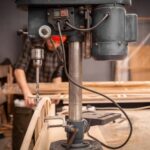Are you itching to roll up your sleeves and start creating with wood? If so, you’re not alone. Woodworking is a timeless craft that offers both practical and artistic satisfaction. It’s a hobby that can turn into a fulfilling profession or simply serve as a relaxing pastime. In this article, we’ll explore what you need to start woodworking, from essential tools to safety precautions and project ideas for beginners.
Whether you’re drawn to the idea of crafting useful items for your home or expressing your creativity through woodworking projects, getting started requires some basic equipment and knowledge. From hand tools like chisels and saws to power tools like drills and sanders, there’s a wide range of tools at your disposal for creating beautiful pieces from wood.
But it’s not just about the tools – safety is also paramount when working with wood. We’ll discuss tips on safety gear, precautions, and best practices to prevent accidents and injuries in the workshop. And don’t worry if you’re completely new to woodworking; we’ve got a roundup of the best learning resources for mastering woodworking techniques and honing your skills.
So whether you want to build simple shelves for your home or create intricate wooden art pieces, we invite you to dive into the world of woodworking with us and discover the endless possibilities it offers. Ready to embark on this exciting journey? Let’s get started.
Essential Tools
Starting woodworking can be an exciting and fulfilling endeavor, whether it’s done as a hobby or a profession. But one of the most common questions for beginners is what you need to start woodworking. The answer lies in having the essential tools that will allow you to create beautiful and sturdy woodwork. Here are some basic tools required to begin your journey in woodworking.
Hand Tools
Hand tools are crucial for woodworking and include items such as hammers, chisels, hand saws, planes, measuring tools, screwdrivers, and clamps. These tools allow for precision and attention to detail when working with wood.
Power Tools
Power tools can significantly speed up the woodworking process and include essentials such as a circular saw, jigsaw, power drill, random orbital sander, router, and table saw. Investing in quality power tools can make a world of difference in the efficiency of your woodworking projects.
Safety Gear
In addition to the essential tools mentioned above, it’s important to invest in safety gear. This includes items such as protective eyewear, ear protection, respirators or dust masks, and gloves. Safety should always be a top priority when working with wood and using power tools.
To start your journey in woodworking, ensuring that you have these essential hand tools and power tools will set you up for success in creating beautiful pieces of woodwork. Each tool serves a specific purpose and is crucial for various stages of the woodworking process. With these tools at your disposal, you’ll be well-equipped to embark on your woodworking journey with confidence.
Safety Precautions
Woodworking is an exciting and fulfilling hobby to pursue, but it’s important to prioritize safety in the workshop. Proper safety gear, precautions, and best practices are essential for preventing accidents and injuries while working with wood. When starting woodworking, there are several key safety measures that you need to keep in mind to ensure a safe and enjoyable experience.
One of the most crucial pieces of safety equipment when woodworking is eye protection. Whether it’s goggles or a face shield, it’s important to protect your eyes from flying wood chips, dust, and debris. Additionally, hearing protection is also essential when working with power tools that produce loud noises. Earplugs or earmuffs can help prevent hearing damage over time.
In addition to protective gear, it’s important to follow proper safety precautions and best practices in the workshop. This includes keeping your work area clean and free of clutter to prevent tripping hazards, as well as using tools properly and maintaining them regularly. Understanding how each tool works and practicing safe usage is fundamental in preventing accidents.
Another crucial aspect of workshop safety is proper ventilation to control sawdust and wood particles. A well-ventilated space can help minimize respiratory issues caused by prolonged exposure to wood dust. Alongside these precautions, it’s also important to have a first aid kit readily available in case of minor injuries or accidents.
When starting out in woodworking, ensuring that you have the right safety gear and are following best practices will set you up for success in your new hobby or profession.
| Key Safety Measures | Importance |
|---|---|
| Eye protection | Protects eyes from flying wood chips, dust, and debris |
| Hearing protection | Prevents hearing damage from loud power tools |
| Ventilation | Controls sawdust and wood particles for better respiratory health |
For more comprehensive protection against respiratory issues caused by prolonged exposure to sawdust an N95 mask can be useful.
Choosing the Right Wood
When starting out in woodworking, one of the most important considerations is choosing the right type of wood for your projects. The type of wood you use can greatly affect the outcome of your project, as well as its durability and aesthetics. This section will provide a guide to selecting the best types of wood for different woodworking projects, including tips on wood quality and sustainability.
Understanding Wood Types
Wood comes in a variety of types, each with its own unique characteristics and properties. Softwoods such as pine and cedar are often used for construction and outdoor projects due to their resistance to decay and ease of workability. Hardwoods like oak, maple, and cherry are prized for their strength, durability, and beautiful grain patterns, making them ideal for furniture-making and interior projects.
Factors to Consider
When choosing wood for a project, it’s important to consider several factors such as the intended use of the item, budget constraints, and availability of different wood species. Additionally, understanding the sustainability of the wood is crucial in making environmentally-conscious choices. Look for certifications such as FSC (Forest Stewardship Council) or sustainably harvested labels to ensure that the wood has been sourced responsibly.
Quality and Grading
Wood quality varies depending on factors such as grain pattern, knots, warping, and moisture content. Familiarizing yourself with wood grading systems can help you select the best quality lumber for your projects. Clear grade lumber has minimal knots and defects, making it suitable for fine woodworking applications. Lower grades may contain more imperfections but can still be used for rustic or utilitarian projects.
By understanding these considerations when choosing wood for your woodworking projects you can ensure that you achieve the desired results while also being mindful of sustainability and quality standards.
Setting Up Your Workshop
So, you’ve decided to start woodworking, and now you’re wondering what you need to start woodworking. One of the most important aspects of beginning your woodworking journey is setting up your workshop. Having a functional and organized space will not only make your projects more efficient but also safer. When setting up your workshop, there are a few key considerations to keep in mind.
First and foremost, consider the layout of your workshop. You’ll want to have designated areas for different tasks such as cutting, sanding, and assembly. It’s important to have a clear workflow and easy access to all of your tools and machinery. Additionally, consider the flow of natural light and ventilation in your space for a comfortable working environment.
Another important aspect of setting up your workshop is storage solutions. Proper storage is crucial for keeping your workspace organized and safe. Invest in sturdy shelves, cabinets, and tool racks to keep everything in its place when not in use. This will not only prevent accidents but also save you time searching for the right tool when you need it.
Lastly, safety should be a top priority when setting up your woodworking workshop. This includes proper lighting, fire extinguishers, first aid kits, and safety gear such as goggles and ear protection. Take the time to assess any potential hazards in your workshop and address them before starting any projects.
Learning Resources
When you are starting out in woodworking, it can be overwhelming to figure out where to begin. One of the most important things you need to start woodworking is access to learning resources that can help you acquire the necessary skills and knowledge. Fortunately, there are many great books, websites, and online courses available to guide you through your woodworking journey.
Books are a fantastic resource for learning woodworking techniques and skills. They often provide step-by-step instructions, along with illustrations and diagrams, making it easier for beginners to understand the process. Some popular titles include “The Complete Manual of Woodworking” by Albert Jackson and “The Essential Woodworker” by Robert Wearing.
In addition to books, there are numerous websites dedicated to teaching woodworking skills. These websites often feature tutorials, project plans, and forums where you can interact with other woodworkers. Websites such as The Wood Whisperer, Fine Woodworking, and Popular Woodworking are valuable resources for beginners looking to expand their knowledge.
Online courses have also become increasingly popular for individuals wanting to learn woodworking from the comfort of their own homes. Platforms like Udemy, Skillshare, and YouTube offer a wide range of courses taught by experienced woodworkers. These courses cover topics such as basic carpentry skills, furniture making, and even how to use specific tools.
Overall, having access to these learning resources is crucial when starting out in woodworking. Whether you prefer learning from books or online platforms, there is a wealth of information available to help you develop your woodworking skills and embark on your creative journey.
| Resource Type | Examples |
|---|---|
| Books | “The Complete Manual of Woodworking,” “The Essential Woodworker” |
| Websites | The Wood Whisperer, Fine Woodworking, Popular Woodworking |
| Online Courses | Udemy, Skillshare |
Project Ideas for Beginners
If you are just starting out in woodworking, it can be helpful to begin with simple yet rewarding projects that allow you to practice fundamental skills while producing something useful and beautiful. Here are some project ideas for beginners:
1. Simple Wooden Shelf: Building a basic wooden shelf is a great way to practice measuring, cutting, and assembling pieces of wood. It’s also a practical project that can be used to display small items or hold books.
2. Picture Frame: Creating a wooden picture frame provides an opportunity to practice making precise miter cuts and assembling pieces at perfect right angles. Plus, the finished product makes a lovely gift or keepsake.
3. Wooden Serving Tray: Crafting a serving tray allows beginners to work on their woodworking skills while also creating a functional item for everyday use. This project can involve cutting, joining, and finishing techniques that are essential for many other woodworking projects.
By starting with these beginner-friendly woodworking projects, you can gain confidence in your skills and develop a solid foundation for more complex projects in the future. As you complete each project, take note of what tools were most useful and which ones you may need to acquire in the future.
Remember that safety should always be a priority when working with woodworking tools, so be sure to follow all safety precautions as outlined in the previous section on Safety Precautions.
Next Steps
Now that you have the basic skills and tools, it’s time to take your woodworking to the next level. Whether you are looking to improve your craft or even turn it into a potential career, there are several steps you can take to continue progressing in woodworking.
1. Advanced Techniques: Once you have mastered the basics of woodworking, you may want to explore more advanced techniques such as joinery, intricate carving, or woodturning. Consider taking specialized classes or workshops to learn these advanced skills from experienced craftsmen. Additionally, practicing these techniques regularly will help you become more proficient and confident in your abilities.
2. Project Ideas: As you gain more experience in woodworking, you can challenge yourself with complex and ambitious projects. Consider building furniture pieces such as tables, chairs, or cabinets. Alternatively, try your hand at creating decorative items like wooden sculptures or intricate picture frames. Exploring new project ideas will allow you to apply and refine your skills while expanding your creativity.
3. Potential Career Paths: If woodworking has become a true passion for you, there are various career opportunities in the field that you can explore. These may include becoming a professional woodworker creating custom pieces for clients, working in furniture making and restoration, or potentially even teaching woodworking classes yourself.
Remember that continuing education and practice are essential for honing your skills in woodworking. Embracing new challenges and constantly seeking improvement will help you grow as a woodworker and open up new possibilities for your future in this craft.
Conclusion
In conclusion, embarking on a woodworking journey can be an incredibly fulfilling and rewarding experience. By starting with the essential tools, prioritizing safety precautions, choosing the right wood, setting up a functional workshop, and utilizing learning resources, you can lay a strong foundation for your woodworking endeavors. Whether you are interested in pursuing woodworking as a hobby or as a potential career path, the key is to continue honing your skills and exploring new project ideas.
It’s important to remember that everyone has to start somewhere, and with dedication and practice, you can progress from simple beginner projects to more advanced techniques. Don’t be afraid to make mistakes along the way – they are all part of the learning process. As you gain more experience in woodworking, you may also discover your own unique style and preferences when it comes to creating beautiful and functional pieces.
So what are you waiting for? Take the plunge into the world of woodworking and unlock your creativity and craftsmanship. With the right tools, knowledge, and determination, there’s no limit to what you can achieve in this timeless craft. Whether you’re building furniture for your home or crafting handmade gifts for loved ones, woodworking offers endless possibilities for self-expression and satisfaction. Get ready to start your woodworking journey today.
Frequently Asked Questions
What Does a Beginner Woodworker Need?
A beginner woodworker needs a few essential tools to start, such as a hammer, tape measure, chisels, handsaw, and a cordless drill. They will also need safety equipment like goggles, gloves, and a dust mask.
What Do I Need to Start a Wood Workshop?
To start a wood workshop, you will need a suitable space to work in, with good ventilation and proper lighting. You’ll need to invest in power tools like a table saw, band saw, router and lathe. Additionally, having a workbench and storage for materials is essential.
How Do I Start Woodworking From Scratch?
Starting woodworking from scratch requires learning basic woodworking skills through books, online tutorials, or classes. It’s important to practice measuring and cutting techniques before moving on to more complex projects. Building a collection of essential tools is the next step before beginning your first woodworking project.

Hi everyone! I’m a woodworker and blogger, and this is my woodworking blog. In my blog, I share tips and tricks for woodworkers of all skill levels, as well as project ideas that you can try yourself.





